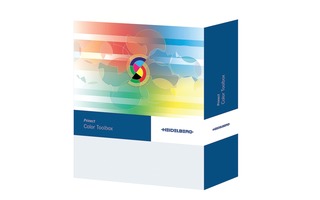Hybrid Workflows and Cross-Platform Color Management
As commercial printers expand into marketing services, short-run color and same-day service, printed materials are being produced on a variety of output devices, including sheetfed presses, digital presses, and wide-format inkjet devices.

As commercial printers expand into marketing services, short-run color and same-day service, printed materials are being produced on a variety of output devices, including sheetfed presses, digital presses, and wide-format inkjet devices.
The challenge for most commercial printers is to put the best-engineered, most cost-effective solutions in place to meet the requirements of any print media campaign a customer requests. Printers also must ensure that all components of the campaign—from the mailer to the brochure to the grand-format signage—are impeccably color-matched. Progressive printers view this as a golden (read: highly profitable] opportunity.
At GRAPH EXPO 2012, Heidelberg is demonstrating a flexible, seamless solution consisting of a Speedmaster SM 52 Anicolor press, Rastek H652 UV flatbed inkjet printer, and Linoprint Pro C901 digital press, united by Heidelberg’s integrated color management and Prinect workflow. Heidelberg’s demo job this year—a simulated retail promotion—is notable not only for the quality of its components, but also for the way the pieces fit together. In essence, Heidelberg’s exhibit represents the ultimate in hybrid, color-managed production: offset and digital united by Heidelberg’s Prinect workflow for maximum productivity and cost efficiency.
Many commercial printers who operate conventional offset and toner-based digital color equipment also have branched into wide-format inkjet to leverage the technology's high-margin opportunities. The most economical and efficient way a commercial printer can implement this strategy is to take the right tools for the job into his hands. Like a well-equipped golfer, he must be free to choose the most effective “club” with which to get the job done. For example, while the cover of a brochure may be printed on an offset press with UV coating, the inside pages may be printed on a digital press, the signage on grand-format inkjet device.
But there's more to the story. Early on, printers strove to make their offset presses print the same. Later, they labored to make early inkjet proofs look like the press sheet. More recently, their goal was to make digital press output look like offset printing. Now, the color of the logo on a 24-foot banner must look the same as the corporate logo color on all the other printed material produced for a specified campaign. But because color variance is unavoidable in campaigns printed on multiple devices, the beating heart of hybrid workflows—and the source of considerable added value—is the degree of color management expertise a printer can demonstrate in ensuring that color is consistent from device to device.
A clear advantage belongs to the commercial printer who can demonstrate efficient, cost-effective, multi-process color management. Under the right circumstances, the same color-managed workflow that supports a printer's offset department can give all of the components in a print marketing campaign the same look, feel, and color-consistency.
How can the commercial printer accomplish this? Two technologies vastly simplify the process. The first is a common “hybrid” workflow integrated via JDF with an offset press, as well as with cut-sheet digital and grand-format inkjet devices. Properly implemented, this type of workflow reduces errors, eliminates redundancies, and gives a printer the most cost-effective way to produce the job. With Heidelberg’s newly enhanced Prinect Digital Print Manager, for example, printers can integrate their digital printing systems bidirectionally into the Prinect management and production workflow in the same way as offset presses, enabling them to route jobs quickly to the most cost-efficient production equipment. The majority of professional digital print systems currently installed in print shops can be integrated in Prinect workflow using Prinect Digital Print Manager.
The second element is a color-managed workflow based on ICC profiling, an easy-to-use “super technology" that yields measureable savings while delivering a higher-quality product. ICC color management supports a wide variety of workflows used for a variety of color reproduction goals.
ICC profiling becomes even more important as print jobs morph into media campaigns. Such a campaign most likely will make use of several different substrates that have the potential to compromise color consistency. Heidelberg's full-spectrum solution for multi-process color management is Prinect Color Toolbox, a G7-certified suite of tools for device calibration, ICC profile generation, and proof/print analysis. Automated color management with Prinect Color Toolbox gets digital and grand-format digital inkjet jobs into production quickly, with no guessing what the color will look like. Users are perfectly prepared to produce anything their customers require efficiently, cost-effectively, and at the highest quality.
Color management, combined with hybrid workflows, are the keys to success on any campaign that blends toner-based and digital wide-format inkjet output with offset. Printers that add these technologies gain the ability to produce the high-margin jobs their customers used to go elsewhere to buy, and rewards including higher selling prices and fatter profit margins.
